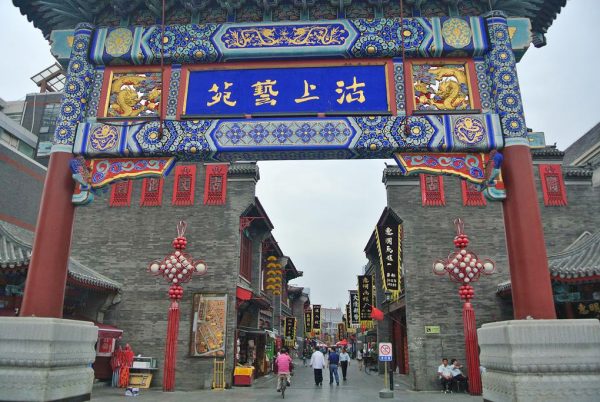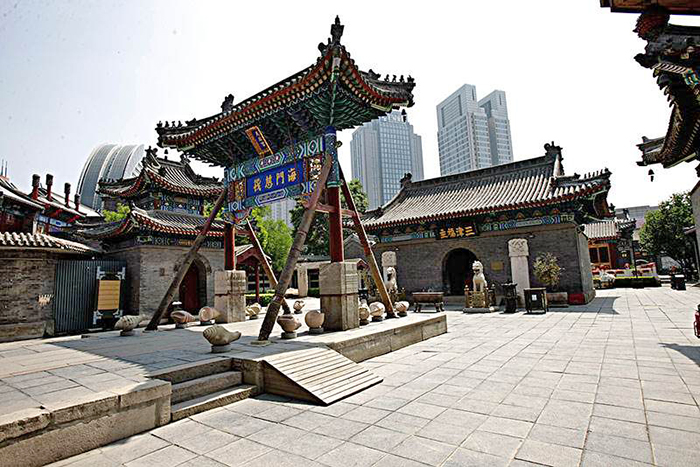
Located on the west bank of the majestic Hai River, Tianjin Ancient Culture Street attracts visitors from across the country, all seeking to admire its architecture, purchase some of the folk handicrafts on sale in its stores, and sample some traditional Tianjin-style snacks. This business street extends for 687 metres (2,254 ft.), from Gongbei Avenue in the north to Gongnan Avenue in the south. Although the street wasn’t officially opened until 1986 and many of its buildings only date back to the 1980s, they were designed to imitate the classical architectural styles of the Ming (1368-1644) and Qing (1644-1912) dynasties. Chinese blue-bricks were used instead of cement in order to give the buildings a more authentic appearance. Walking down this narrow alleyway, you’ll feel transported back in time to ancient China; providing you ignore the skyscrapers in the distance, of course!
While the term “ancient” may seem like something of a misnomer, the street isn’t strictly occupied by historical replicas. The Tianhou Palace, which rests at the centre, was originally constructed in 1326, during the Yuan Dynasty (1271-1368), although it has since been repeatedly renovated. The palace houses one of the only three surviving temples in China dedicated to the goddess Mazu. Since Tianjin was a trading port of great historical prominence, it is understandable that they would place so much emphasis on Mazu, as she was widely regarded to be the goddess of seafarers and fishermen.
According to local legend, it is believed that she was a shamaness named Lin Mo who was born in Putian of Fujian province. She was apparently much more intelligent than other children of her age, and could predict the good or ill luck of others with startling accuracy. After her death, she supposedly continued to help merchants and fishermen in times of danger. Alongside the temple, the palace contains the Opera Hall, the Cannon-Storing Pavilion, the Bell-Drum Tower, the Memorial Archway, the Qisheng Temple, and the Zhangxian Pavilion, among other attractions. Throughout its myriad of halls, you’ll find dazzling displays of folk handicrafts and ancient cultural relics.
To this day, the palace is still used for ceremonial rituals that are held in honour of Mazu, the largest of which is the 4-day Huanghui Fair. This grand folk fair is held every year around the 23rd day of the third month according to the Chinese lunar calendar, as this is believed to be Mazu’s birthday. During this time, the street comes to life with magnificent performances, such as dragon dances, lion dances, Shaolin martial arts, stilt walking, folk dancing, Peking opera, and local opera.

The Tianhou Palace may seem to have the greatest historical pedigree, but it’s technically not the oldest resident on the street! The Yuhuang Taoist Temple, a two-floor pavilion offering a bird’s eye view of the entire street, dates back to the Ming Dynasty and is the oldest structure still in its original form. Its doors and windows are resplendent with colourful paintings, depicting scenes from classical texts such as Dream of the Red Chamber and Song of Everlasting Sorrow. From legendary tales and historical events to simple tableaus of flowers and birds, these paintings are a feast for the eyes.
With over a hundred stores selling a variety of handicrafts and antiques, Tianjin Ancient Culture Street is also the ideal location to pick up a few souvenirs. The famed Yang Liuqing New Year Paintings and Niren Zhang Painted Sculptures are both sold here, resting alongside a plethora of jade carvings, cloisonné, embroidery, calligraphy brushes, silver jewellery, and traditional pottery. If you’re feeling peckish, there are plenty of street-food vendors and restaurants sandwiched between the numerous stores. Local delicacies such as Goubuli Steamed Dumplings, Erduoyan (Ear-hole Lane) Fried Glutinous Cakes, and Tea Soup are sure to help keep your stamina up during those long hours of browsing and bargaining!